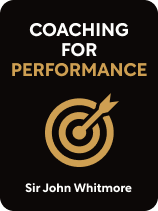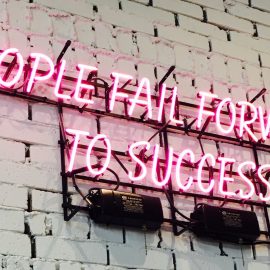

This article is an excerpt from the Shortform book guide to "Coaching for Performance" by Sir John Whitmore. Shortform has the world's best summaries and analyses of books you should be reading.
Like this article? Sign up for a free trial here.
What is the GROW model in coaching? When should you use it? What are the four stages of the GROW model?
The GROW model in coaching was developed by Sir John Whitmore and his colleagues as a way to help employees set goals, maximize their potential, and improve performance. The GROW model has four stages and focuses on having the employee take ownership of their work to improve self-reliance.
Read on to learn more about the GROW model in coaching and how to use it, according to Whitmore.
Sir John Whitmore’s GROW Model
According to Sir John Whitmore’s book, Coaching for Performance, you can help your coachee illuminate and achieve goals using the GROW model. But, what is the GROW model in coaching and how should you use it to get the best results? In this article, we’ll explore the answers to both of these questions.
What Is the GROW Model in Coaching?
The GROW model in coaching is a framework performance consultant Sir John Whitmore and his colleagues developed in the late 1980s to help employees set goals, maximize their potential, and improve performance.
The model has four stages:
- Goal Setting. Identify your coachee’s immediate and end goals.
- Reality. Assess whether your coachee has chosen a realistic goal.
- Options. Explore all possible actions the coachee could take to achieve their goal.
- Will. Determine your coachee’s determination to follow through on their goal by outlining specific steps, timeframes, and accountability frameworks for accomplishing it.
(Shortform note: The CLEAR coaching model preceded Whitmore’s GROW model and rests on the idea that managers should develop and guide workers—not just give directives. GROW takes the idea a step further, saying that managers and leaders should maximize employees’ potential by giving them ownership of their work. Another difference between the models: CLEAR focuses on coachees’ motivation and behavior, while GROW centers more on goal setting, making action plans, and reviewing goals. CLEAR stands for Contract (define your coachee’s work), Listen to your coachee’s feelings, Explore your coachee’s beliefs and assumptions, Action (make a plan), and Review your coachee’s progress.)
How Do You Use It?
Now that we understand what the GROW model in coaching is, according to Whitmore’s definition, we’ll explain the four stages of the model by breaking them down into steps so that you can use them effectively in your next coaching session.
Step 1: Develop a Goal
When using the GROW model in coaching, coaches and coachees should set two types of goals at the start of their session: a big-picture goal and performance goals. The first type of goal grounds and guides session, so you always know what you’re aiming for and can stay on track. The second type allows you and your coachee to assess the progress they’re making to achieve their broader goal. Goals should be realistic, specific, tied to a clear timeframe, measurable, and agreed upon.
(Shortform note: In Grit, Angela Duckworth suggests a different way to think about and set goals: Frame goals as a multi-level hierarchy. Low-level goals are at the bottom and include daily actions like writing emails and going to meetings. These goals are a means to an end to achieve higher goals, like completing a work project. To determine each level of goals, continually ask yourself why you’re doing each task you’re doing and why you care about it. Each answer will send you to the next level until you have no answer. At that point—when you want something just because you want it—you’ve reached your highest level goal, the one you’ll dream about, fight for, and demonstrate grit to achieve.)
Step 2: Make the Goal Realistic
Coaches and coachees must ensure that goals are realistic so they can reasonably be achieved when using the GROW model in coaching. To do this, be objective, emotionally disengaged, and use neutral language. This will prevent biases, judgments, and expectations from distorting your and your coachee’s perception of what’s realistic and their potential for success. For example, don’t say, “This is a bad goal.” Instead, try, “I think this goal may not be as achievable as it could be because it’s general. We can strengthen it by making it more specific.”
(Shortform note: Not everyone agrees with setting realistic goals. In Principles: Life and Work Ray Dalio recommends that you shoot for the stars when setting goals. He says the only reason you think you can’t achieve a goal is that what you know right now is limited. But when you start working to achieve your audacious goal, paths that you couldn’t conceive of will present themselves to you. So, don’t let fear of the unknown stop you from setting bold goals.)
Step 3: Explore Action Options
Once your coachee has a goal, work with them to brainstorm all possible actions they can take to achieve it. Whitmore says you should focus on quantity, not practicality, of ideas to foster creativity. Welcome all ideas, no matter how small or seemingly silly.
(Shortform note: Experts recommend several visual brainstorming techniques Whitmore doesn’t, including mind mapping, where you generate ideas without the constraints of structure or order using colorful visuals. Bubble maps are another option: Draw three rows of three circles. Write a problem you want to solve in the middle circle and fill surrounding bubbles with solutions. When all bubbles are full, move an idea from an outside bubble to the middle and begin again.)
Step 4: Determine Your Coachee’s Will to Execute Their Goal
According to the final stage of the coaching GROW model, you should assess your coachee’s determination to achieve their goal to maximize their chances of attaining it. To do this, have them develop a plan with the following information:
- Specific actions they’ll take to achieve their goal
- The timeframe in which they’ll accomplish each step. This should be specific and carry some urgency to keep momentum going.
- Obstacles they may encounter and supports they might need. This helps them prepare for and remediate potential roadblocks.
- How you’ll know if they change their mind about part of the plan.This helps ensure they remain accountable and that you’re both on the same page.
- How they plan to measure their progress. This keeps them on track.
- Their level of commitment to their plan on a scale of 1-10. Whitmore says that your coachee is unlikely to follow through on anything less than an eight. If they indicate a number lower than this, ask what barriers exist that keep that number from being a 10.
(Shortform note: Whitmore doesn’t go into detail about the possibility that your coachee won’t make progress. Experts say that several factors can block people’s innate motivation to perform at work, including home stressors and the feeling that their bosses don’t genuinely care about them. In the latter case, they may resent their boss and view performance pep talks as hollow. To avoid this, leaders should work with workers to understand challenges they face, assess their own role in those challenges, and take steps to resolve the problem.)
Once your coachee’s plan is set, schedule regular check-ins to discuss their progress and give feedback. Deliver feedback in a positive, non-confrontational way to encourage them to share openly, learn from the experience, and gain confidence in their actions.
For example, ask, “What’s going well?” “Are there things you’d do differently a second time around?” and, “What are you learning?” This will prompt your coachee to process their experience at a deeper level. It also offers a model to assess their own progress and performance, which gives them ownership and makes them more self-reliant.
(Shortform note: In addition to sharing positive feedback, experts suggest that you give feedback as promptly and specifically as possible because the brain’s best learning occurs when it’s in action. So, praise your coachee as soon as you identify an area of strength or progress, and be specific about what worked so they know what you’d like to see more of. The more you give feedback in this way, the more you’ll normalize the feedback process—turning performance reviews into friendly discussions rather than hot seats.)
Once your coachee has achieved their goal, have a final conversation to share feedback and wrap up. Ask your coachee how things turned out, what they learned, and how they’ll apply what they learned in the future. This allows them to reflect on the coaching process as a whole and recognize their self-efficacy, which will further build their confidence, attunement, and ownership and maximize their potential and performance.
(Shortform note: There are many ways to wrap up a final coaching session. One leadership coach recommends the following steps: First, ask your coachee to name their biggest insights and results from their work and what habits they’ll take away from it. Second, ask about their biggest dream in the year ahead and the first tiny step they’ll take to reach it. Third, have them pretend it’s three years in the future and they’ve achieved professional and personal success. Ask what their future self would tell you about what’s happened since you last worked together. Fourth, if you believe you can help your coachee achieve this dream, ask if they’d like to work with you on it. Finally, give them a gift card for a free session to encourage their return.)

———End of Preview———
Like what you just read? Read the rest of the world's best book summary and analysis of Sir John Whitmore's "Coaching for Performance" at Shortform.
Here's what you'll find in our full Coaching for Performance summary:
- A guide on the ins and outs of performance coaching
- Strategies to maximize employees’ potential and performance
- How to measure organizational culture and the impact of your work






